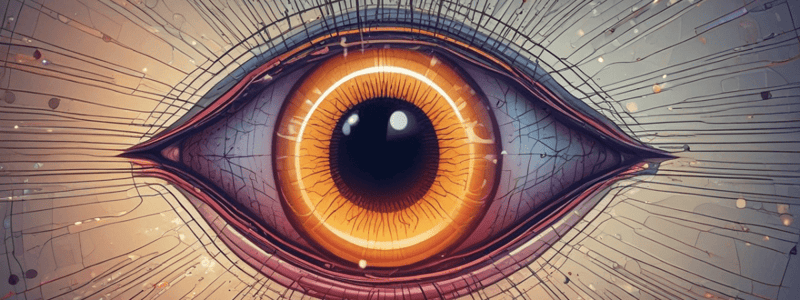Podcast
Questions and Answers
What is the expected outcome when performing the Pupillary Light Reflex test?
What is the expected outcome when performing the Pupillary Light Reflex test?
- Both pupils will dilate
- The pupil exposed to light will constrict, and the opposite pupil will also constrict (correct)
- Both pupils will remain unchanged
- The pupil exposed to light will constrict, and the opposite pupil will dilate
What is the purpose of the Near Reaction test?
What is the purpose of the Near Reaction test?
- To evaluate the convergence and accommodation of the eyes (correct)
- To test the direct and consensual reaction to light
- To assess pupillary constriction to light
- To assess the six cardinal positions of gaze
Which cranial nerve is responsible for innervating the superior oblique muscles?
Which cranial nerve is responsible for innervating the superior oblique muscles?
- Cranial nerve III (oculomotor)
- Cranial nerve IV (trochlear) (correct)
- Cranial nerve VI (abducens)
- Cranial nerve II (optic)
What is the expected outcome when testing the Extraocular Muscles?
What is the expected outcome when testing the Extraocular Muscles?
What type of movement is typically checked for during the Extraocular Muscle test?
What type of movement is typically checked for during the Extraocular Muscle test?
How is visual information transmitted from the eye to the brain?
How is visual information transmitted from the eye to the brain?
What is the purpose of assessing the Range of Peripheral Visual Fields?
What is the purpose of assessing the Range of Peripheral Visual Fields?
What is the primary purpose of assessing the corneal light reflex during a physical exam?
What is the primary purpose of assessing the corneal light reflex during a physical exam?
What is the purpose of the pupillary light reflex test?
What is the purpose of the pupillary light reflex test?
What is the primary purpose of assessing extraocular muscle function?
What is the primary purpose of assessing extraocular muscle function?
What is the purpose of visual field assessment?
What is the purpose of visual field assessment?
During the pupillary light reflex test, what is the normal response to light?
During the pupillary light reflex test, what is the normal response to light?
What is the purpose of assessing the direct and consensual reflex during the physical exam?
What is the purpose of assessing the direct and consensual reflex during the physical exam?
What is the purpose of the accommodation test during the physical exam?
What is the purpose of the accommodation test during the physical exam?
What is the primary cause of Abnormal increase in IOP in Chronic-open angle Glaucoma?
What is the primary cause of Abnormal increase in IOP in Chronic-open angle Glaucoma?
What is the most common symptom of Age Related Macular Degeneration?
What is the most common symptom of Age Related Macular Degeneration?
What is the primary symptom of Wet (Neovascular) Age Related Macular Degeneration?
What is the primary symptom of Wet (Neovascular) Age Related Macular Degeneration?
What is a common risk factor for Chronic-open angle Glaucoma?
What is a common risk factor for Chronic-open angle Glaucoma?
What is a symptom of Cataracts?
What is a symptom of Cataracts?
What is a characteristic of Acute Closed Angle Glaucoma?
What is a characteristic of Acute Closed Angle Glaucoma?
What is a symptom of Dry (Atrophic) Age Related Macular Degeneration?
What is a symptom of Dry (Atrophic) Age Related Macular Degeneration?
What is the visual field defect that results from an optic chiasm cut?
What is the visual field defect that results from an optic chiasm cut?
Which of the following is a characteristic of a normal optic disc?
Which of the following is a characteristic of a normal optic disc?
What is the visual field defect that results from a right optic tract cut?
What is the visual field defect that results from a right optic tract cut?
What is the part of the ophthalmoscope that allows the examiner to see the retinal vessels?
What is the part of the ophthalmoscope that allows the examiner to see the retinal vessels?
What is the normal color of the retinal background?
What is the normal color of the retinal background?
What is the location of the macula in relation to the optic disc?
What is the location of the macula in relation to the optic disc?
What is the purpose of the ophthalmoscope?
What is the purpose of the ophthalmoscope?
What is the result of the crossing of fibers in the optic chiasm?
What is the result of the crossing of fibers in the optic chiasm?
What is the part of the retina that is responsible for central vision?
What is the part of the retina that is responsible for central vision?
Flashcards are hidden until you start studying
Study Notes
Pupillary Light Reflex
- To test the pupillary light reflex, have the patient gaze into the distance and shine a pen light onto the eye from the side
- Direct reaction: normally, the pupil exposed to bright light will constrict
- Consensual reaction: normally, the opposite pupil will also constrict
Assessing for Near Reaction: Convergence and Accommodation
- Hold a finger in front of the patient's nose, 12 inches away, and have them focus on it
- Pupils will normally dilate when focusing on a far object
- Move the finger closer (3 inches from the face) and the pupils will normally constrict and converge as the finger moves closer
Testing Extraocular Muscles
- Hold a finger about 12 inches from the patient's face and have them follow it through the six cardinal positions of gaze
- Should have parallel tracking of the eyes
- Check for nystagmus (fine oscillating movement) and lid lag
- Cranial nerve VI (abducens) innervates the lateral rectus muscles
- Cranial nerve IV (trochlear) innervates the superior oblique muscles
- Cranial nerve III (oculomotor) innervates all the rest: superior, inferior, medial rectus, and inferior oblique
Assessing Range of Peripheral Visual Fields
- Assess the range of peripheral visual fields
Visual Fields and Visual Pathways
- Visual fields: projected upside down and reversed right to left
- Visual pathways: nerve impulses are conducted through the retina, optic nerve, optic chiasm, and optic tract on each side, and then through a curving tract called the optic radiation
Subjective - History
- PMH: history of ocular problems, strabismus, glaucoma, cataracts, eye trauma, macular degeneration, medications for eyes/eyedrops, diabetes, and hypertension
- PSH: prior surgery involving the eyes (LASIK, cataract removal, etc.)
- FMH: family history of genetic eye conditions, such as macular degeneration, retinitis pigmentosa, retinoblastoma, glaucoma, night blindness, etc.
Review of Systems (ROS)
- Ask about recent changes in vision, use of contacts/glasses, eye pain, blurred vision, double vision, photophobia, floaters, flashing lights, redness/swelling of eyes, watering/discharge, and date of last eye exam
- Also, ask about self-care behaviors
Objective - Physical Exam
- Assess visual acuity
- Inspect lids and lashes, conjunctiva, sclera, iris, cornea, and shape and size of pupils
- Check corneal light reflex and direct and consensual reflex
- Test accommodation: convergence
- Test extraocular movements
- Test visual fields
- Perform a funduscopic examination
Testing Visual Acuity - Snellen Test
- Position the patient 20 feet from the chart
- Leave glasses on/contacts in
- Shield one eye and have them read the smallest line possible
- Record the fraction noted at the last line read with more than half correct answers
- Record for each eye separately (OD = patient's right eye, OS = patient's left eye)
Abnormal - Impaired Vision
- Myopia (nearsightedness): impaired far vision
- Hyperopia (farsightedness): impaired close vision
Inspect
- Eyebrows: note fullness, hair distribution, and any scaliness of underlying skin
- Eyelids: note width of palpebral fissures, edema, lid color, lesions, condition and direction of eyelashes, and adequacy of eyelid closure
- Eyeball: note alignment in the socket and any protrusion or enophthalmos
- Conjunctiva and sclera: note any swelling or nodules, and ask the patient to look up while using thumbs to lower the bottom lid
- Lacrimal apparatus: note any swelling around the lacrimal gland and lacrimal sac
Studying That Suits You
Use AI to generate personalized quizzes and flashcards to suit your learning preferences.




